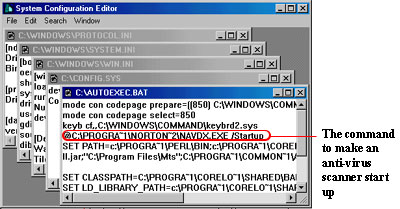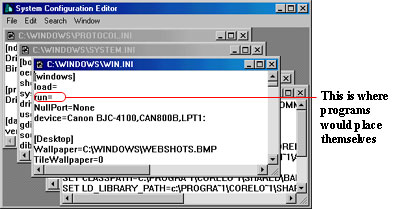Optimizing your Windows PC
Conserving Random Access Memory (RAM)
As you install programs on to your computer,
many of them will want to run every time your computer is turned on. Others,
such as Real Player, or MSN Instant Messenger want to be on all of the time.
This can obviously be a waste of RAM and
of system start up time. The best strategy is to attempt to eliminate as much
of them as possible, and keep only those you are unable to part with. This
page will show you how to hunt down these memory hogs and crush them. After
you have done this, you will most probably notice a significant speed increase,
providing you were low on RAM to begin with.
Step 1 - The System Tray
 |
| The System Tray |
The section of the Task Bar located in the bottom
right portion of your deskop (to the left of your system clock),
is what is commonly referred to as the system tray. This is where
memory resident programs, that are nice enough to make themselves
visible, reside. Their icons allow you to modify their properties
and launch the program when necessary.
Programs which commonly reside in this tray are MSN Instant
Messenger, Real Networks Real Player, Mirabilis/AOL ICQ, to name only very
few.
If your system tray is loaded with icons, you have a problem
on your hands. To prevent these programs from running all the time, right
click on their icon and try to find their properties. In that dialog box,
there will probably be an option somewhere to disable automatic start-up.
If you can't find such an option anywhere in that program, you can still prevent
the application from starting up using another one of the methods described
below.
Step 2 - The Autoexec.bat file
 |
| The System Configuration Editor |
Back in the days of MS-DOS, the autoexec.bat file
used to be the only way a program could load itself into memory
at system startup. And hence, it was extremely easy to free up
memory. Although things have changed since then, and Windows 95
or higher, no longer even require an autoexec.bat file to run
properly, there are still some old programs that may have placed
their start-up in this file.
To easily check your autoexec.bat, choose Run from the Start-Up
menu, and type 'Sysedit' (without the quotes). You will then see a few windows.
Select the one titled autoexec.bat and take a look at what's in there. Each
line in this file, gets executed every time your computer is turned on, as
if someone was at the console actually typing these commands by hand. If you
see lines such as 'c:\progra~1\mcafee\start.exe', it's most probably a program
that you can disable without too many repercussions. To disable a line temporarily,
type 'rem' at the beginning of the line, and then save the autoexec.bat file.
Then try restarting your system to see if you notice any difference. If not,
this application was probably unecessary, and you have successfullly freed
up some memory by disabling it.
Repeat this process for any suspicious lines in this file, until
you are satisfied.
Step 3 - The win.ini file
 |
| The System Configuration Editor - Win.ini view |
In Windows 3.1 (Windows 95's predecessor), the only
way a Windows based program could start-up automatically when
you launched windows, was to place itself in the win.ini file.
Like the autoexec.bat file, new programs won't start up this way,
but you may still have some 16-bit Windows 3.1 applications, that
are starting up this way.
To verify this, choose Run from the Start-Up menu, and type
'Sysedit' (without the quotes). This time select win.ini, and scroll down
until you get to the line 'run = '. Every application specified on this line,
will start up automatically with windows. To diable them, delete the reference
to it's location.
For example, if you see 'run = c:\games\pacman\res.exe;c:\progra~1\word\startme.exe',
then res.exe and startme.exe are two programs that are starting up with your
computer. To remove both of them, modify that line so that it reads 'run =',
and then save the win.ini file.
To be safe, write down somewhere what the line said before saving
any changes, so as to be able to restore the original file, if any errors
occur in the future.
Step 4 - The StartUp folder
Most of you are probably familiar with the StartUp folder. It
is simply a folder, situated in the Start Menu, that gets special treatment
from Windows. Any shortcut placed in this folder, is automatically runned
on start up.
To prevent an application which uses this method to start up
from doing just that, simply place it's short cut somewhere else (such as
the Recycle Bin, or as I like to do, in a special 'Start Up Disabled' folder.
You can get to this folder by selecting Start>Settings>Taskbar,
right clicking on the start menu and then selecting 'Explore'or going through
My Computer and into the Windows folder.
Step 5 - The Windows Registry
 |
| The Windows Registry Editor - Run folder |
The final way a program can make itself start up
with your system, it to place a reference pointing to it in the
windows registry. This method is similar to the win.ini file,
except instead of being stored in a *.ini file, the reference
is stored in the for of a registry key.
To access the registry select Start>Run, and then type 'regedit'.
On the left side of the screen, you should see a file structure.
Follow the following path to get to the run section:
HKEY_CURRENT_USER >
Software >
Microsoft >
Windows >
CurrentVersion >
Run
Here you should see a few registry keys, which you can delete
as you wish. Deleting a particular registry key should prevent the specified
application from starting up automatically.
You should however be warned that editing the System Registry
is a dangerous practice and can lead to many problems. But I wouldn't worry
too much; I've been editing the Syystem Registry for a long time, and have
never had a problem.
Next Page:
Increasing the Speed of your Processor (Overclocking)
Skip Ahead:
Removing the Windows wait time
Preventing Windows from resizing the swap file
Removing useless animations and sounds
Save disk space